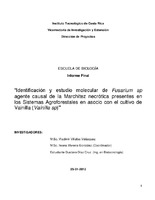Identificación y estudio molecular de Fusarium sp agente causal de la Marchitez necrótica presentes en los Sistemas Agroforestales en asocio con el cultivo de Vainilla (Vainilla sp).
Fecha
2012Autor
Villalba-Velásquez, Vladimir
Moreira-González, Ileana
Díaz-Cruz, Gustavo
Metadatos
Mostrar el registro completo del ítemResumen
La vainilla (Vanilla sp) es una orquídea cultivada a nivel mundial, y a partir de la cual se obtiene la vainillina (4-hidroxi-3-metoxibenzaldehído). Dicho extracto es de amplio uso en industrias como la alimenticia, cosmética y farmacéutica, generando altos ingresos para los países exportadores.
Costa Rica está retomando este cultivo mediante sistemas agroforestales; sin embargo, es susceptible al ataque del hongo Fusarium oxysporum f.sp. vanillae, que genera la pudrición de tallos, y aún no existen estrategias de control completamente eficaces. El presente trabajo muestra el aislamiento e identificación de cepas de Fusarium sp asociadas al cultivo de vainilla, y la estandarización de un protocolo de extracción y cuantificación de su ADN, para la identificación mediante PCR.
Se emplearon muestras de hoja, tallo y suelo, a partir de los cuales se aislaron e identificaron cepas de Fusarium sp. Estas fueron procesadas mediante un kit comercial de extracción de ADN, se cuantificaron mediante espectrofotometría, y se usaron para la amplificación del gen EF-1. Se obtuvieron 6 cepas distintas de Fusarium sp, cuyas extracciones mostraron concentraciones bajas de ADN y de pureza regular. A pesar de ello, el gen fue amplificado mediante PCR, pero no se observaron diferencias en la electroforesis en gel de agarosa. ______________________________________________________________________ Abstract:
The Vanilla (Vanilla sp) is an orchid cultivated worldwide, and from which the vanillin (4-Hydroxy-3-methoxybenzaldehyde) is obtained. Such extract has several uses in different industries, like food, cosmetic and pharmaceutical, giving high incomes to the exporter countries.
Costa Rica is returning to this crop by using agroforestry systems; however, it is susceptible to the infection of fungus Fusarium oxysporum f.sp. vanillae, which generates stem rot, and there are no effective control strategies yet. This work shows the isolation and identification of some strains of Fusarium sp associated to vanilla crop, and the standardization of a for extraction and quantification protocol of their DNA, for identification by PCR.
Leaf, stem and soil samples were used, from which Fusarium sp strains were isolated and identified. These were processed by using a commercial DNA extraction kit, they were quantified by spectrophotometry, and were used to amplify the EF-1 gene. Six different strains of Fusarium sp were obtained, and their extractions show low DNA concentrations and regular purity. Nevertheless, the gene was amplified by PCR, but there were no differences in regards to the agarose gel electrophoresis.
Descripción
Proyecto de Investigación
Instituto Tecnológico de Costa Rica. Vicerrectoría de Investigación y Extensión (VIE). Escuela de Biología, 2012


